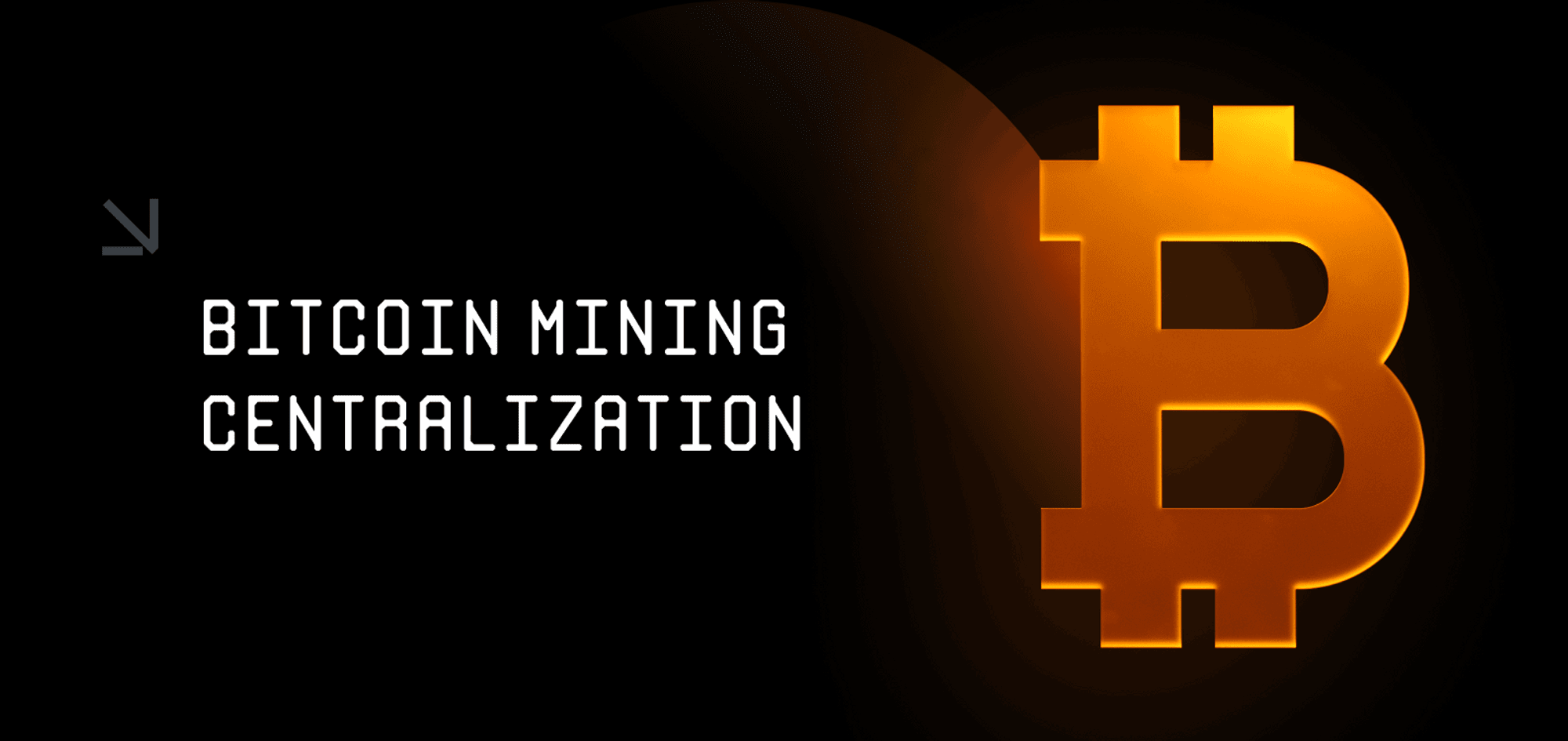
Bitcoin mining centralization
The term centralization stirs mixed feelings among the Crypto community. The very basis of Satoshi Nagamoto’s original paper allowed for direct transactions between parties without the need for a “trusted third party” like a bank. The paper outlined the Proof of Work (PoW) consensus mechanism, which enabled a groundbreaking and secure transaction validation mechanism through miners operating on the network. It also detailed the underlying blockchain technology that continues to serves as a transparent, tamper-resistant ledger for all confirmed Bitcoin transactions.
By using highly distributed transaction processing via compute power on the Bitcoin blockchain, no one actor could compromise that ledger and perform a "51% attack".
Any concerns around a 51% attack are far more at the front of mind for smaller market cap coin developers than the wider Bitcoin community. And with the BTC network processing more transactions than ever before and, as I write this article, Bitcoin whales quietly accumulating means that there’s bullish sentiment in the community.

Bitcoin whales have quietly accumulated again since profit taking above $30k on April 11th (source: Santiment)
With evidence that BTC mining revenue has seen a significant uptick in the past few weeks (via Milkroad.com), it’s time perhaps to look at the current state of centralization on the network and in a more physical sense.
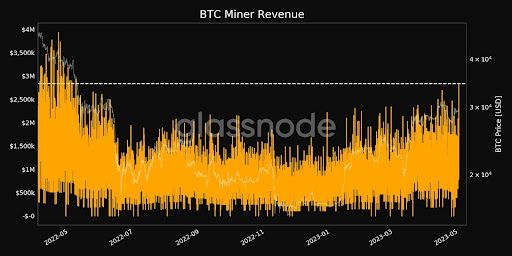
BTC Miner revenue (source: Glassnode)
What are the concerns around Centralization in Bitcoin mining?
Centralization in Bitcoin mining raises several concerns, particularly with respect to the security and integrity of the network. For miners, both small and large, centralization can result in an uneven distribution of mining rewards, leading to a less competitive and less secure mining landscape. Small miners may face challenges in remaining profitable when competing against larger, well-funded entities operating with economies of scale.
“We find that mining activity has been detected at more than 6000 geographical units across 139 countries and regions, which is in line with the distributed design of Bitcoin network. However, in terms of computing power, it has demonstrated a strong tendency of spatial concentration and association with energy production locations.” — Spatial analysis of global Bitcoin mining
This outlook will inevitably lead to some consolidation, reducing overall miner diversity. Some large scale operators are currently focusing on "quick to market", higher efficiency facilities ready for the next halving expected in 2024, while others are partnering to consolidate their operations to achieve economies of scale. In April this year Cleanspark announced an investment to double their hashrate capacity at a cost of around $150m. Whichever way you look at the market in its current position, these are all signs of bullish intentions from operators worth watching.
For mining pool operators, centralization poses risks to the network's security and resilience. If a small number of mining pools control a significant portion of the total hash rate, they may be in a position to manipulate the blockchain, engage in selfish mining, or launch 51% attacks. This could potentially undermine trust in the system and threaten the decentralized nature of Bitcoin.
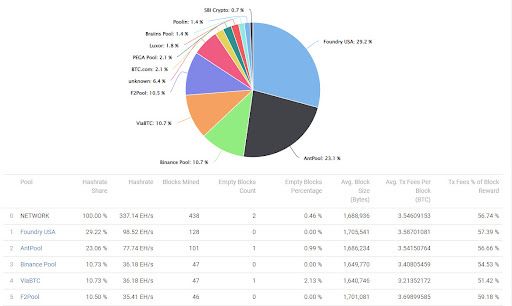
The top 5 BTC miners are providing 84% of the total network hashrate (source: https://btc.com/stats/pool)
Additionally, centralization of mining operations in specific geographic locations, often driven by factors like low electricity costs or favourable regulations, can make the network vulnerable to regulatory actions or localized infrastructure failures. This regional centralization can also lead to unequal distribution of mining rewards and further exacerbate the centralization issue as smaller miners make a loss and close their operations.
Why we shouldn't be worried about Centralization
While those concerns about centralization in Bitcoin mining are valid, there are several reasons why it may not be as alarming as it seems:
Market forces and competition: The mining industry is subject to market forces that promote competition and naturally limit centralization. As larger mining operations capture a significant portion of mining rewards, it incentivizes other players to enter the market and compete, leading to a more diversified mining landscape. The constant drive for innovation in mining hardware, software, and efficiency can help maintain a competitive environment that limits centralization.
Decentralized mining pools: The rise of decentralized mining pools, using technologies like Stratum V2 or the BetterHash protocol, allows individual miners to choose which transactions to include in a block, reducing the potential for mining pool operators to manipulate the network.
Geographical diversification: Although mining operations tend to concentrate in specific regions, there is still a degree of geographical diversification. As energy costs, regulations, and political landscapes change over time, mining operations may shift to different locations, reducing the risk of regional centralization.
Technological advancements: Improvements in mining hardware efficiency, agreements with grid operators and the growth of renewable energy sources can help manage mining power consumption evenly while making it economically viable for smaller miners to participate. Additionally, innovations like Layer 2 solutions and alternative consensus mechanisms can alleviate some concerns related to mining centralization by providing alternative means of transaction validation.
Overall, while centralization in Bitcoin mining is a concern, there are several factors that help mitigate any risk and maintain the network's decentralized nature. Market forces, technological advancements, and community vigilance all contribute to a dynamic and evolving and vibrant mining landscape.
Bitcoin mining is by its very nature, Decentralized
Bitcoin mining is designed to be decentralized through its Proof of Work (PoW) consensus mechanism, which allows anyone with the necessary computing power to participate in mining and compete for block rewards. By distributing the mining process across a global network of individual miners and mining pools, Bitcoin aims to prevent any single entity from controlling the network, maintaining its security, integrity, and resistance to censorship.
The role of the mining difficulty adjustment algorithm
The mining difficulty adjustment algorithm plays a crucial role in managing decentralization by dynamically adjusting the difficulty of the cryptographic puzzle required for mining a new block. This adjustment, which occurs approximately every 2,016 blocks (roughly every two weeks), ensures a consistent block time of 10 minutes on average, regardless of the total hash power of the network. By maintaining this equilibrium, the algorithm prevents any single miner or group of miners from dominating the network, fostering a competitive mining landscape and preserving the decentralized nature of Bitcoin.
The economics of BTC Network Difficulty and ever increasing hashrate
While anyone with access to the internet can participate in mining, BTC mining profitability is incredibly difficult to achieve in many areas around the world because of rising energy costs. For small miners these problems aren’t going away as BTC difficulty is at an all-time high and climbing exponentially.
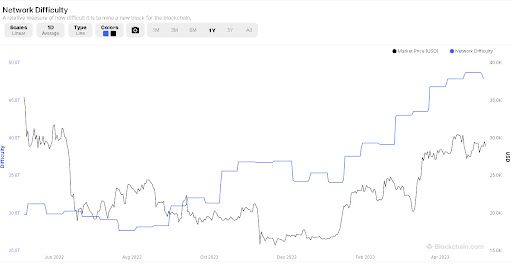
BTC Network Difficulty (source: Blockchain.com)
This trend is precisely why we see mining operators pooling their resources operationally, from an economic standpoint it makes sense. The block reward for mining halves, the cost to mint new Bitcoin increases.
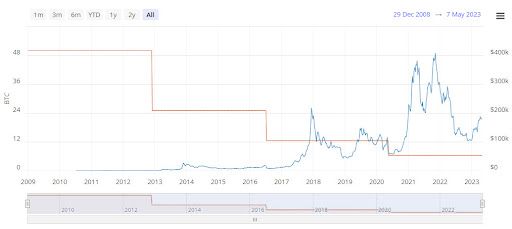
Block reward in comparison to increasing hashate exponentially increases the cost to mint new BTC (source)
So there are benefits to Mining Centralisation?
For miners, yes. Investing in clean energy sources, energy operator agreements and physically partnering at the same location are trends we’ll see more of as operators need to find economies of scale to maintain their profitability.
Marathon Digital Holdings has very recently announced their partnership with Zero Two to develop and operate the first large-scale immersion Bitcoin mining facility to take advantage of power surpluses in Abu Dhabi, which will save costs and help balance the local grid network.
Mining pools involve multiple miners pooling their computational resources together to work on mining new blocks. By doing this, they increase their collective probability of successfully mining a block and share the block rewards proportionally based on each participant's contributed hash power. This collaboration helps individual miners, especially smaller ones, to mitigate the risks associated with the highly competitive and resource-intensive nature of mining.
On the other hand, miners physically partnering at the same location can benefit from shared infrastructure, lower energy costs, and operational efficiencies. By colocating mining operations, miners can access cheaper electricity rates through bulk purchasing, negotiate better deals with hardware suppliers, and optimize their mining setups for better cooling and maintenance. These advantages can significantly reduce the overall costs of mining, making it more profitable for the participating miners.
While these strategies can help miners achieve economies of scale and maintain profitability, they may inadvertently contribute to centralization concerns. As mining operations consolidate, either in mining pools or at shared locations, the distribution of mining power could become increasingly concentrated, potentially impacting the decentralized nature of the Bitcoin network. As a result, it's important to consider the balance between achieving economies of scale and preserving decentralization when pursuing these collaborative approaches.
Hiveon Energy project
The increased demand for collaborative solutions among decentralized businesses has led to a few innovative approaches emerging in the intersection of the blockchain field and traditional industries. One of the projects that need to be mentioned in this regard is Hiveon Energy. It’s a full-scale solution integrated with Hiveon OS that helps mining operators better respond to the availability of the energy grid, thus allowing them to cut energy expenses by up to 30%. Such demand-response programs are based on the idea of balancing the grid load to make BTC mining more friendly to the local community’s needs and the environment.

Market Forces
Market forces prevent excessive centralization and promote decentralization in Bitcoin mining by fostering competition and innovation. It incentivizes miners to drive innovation in mining hardware, software, and efficiency. This competitive landscape helps maintain a diverse ecosystem of miners, preventing any single entity from dominating the network. Additionally, fluctuations in energy costs, regulations, and political landscapes encourage geographical diversification, further limiting the centralization of mining power.
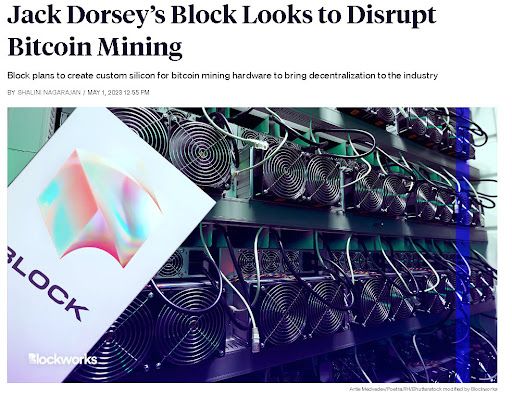
As an example of precisely this phenomenon, Jack Dorsey's Block plans to create custom silicon for Bitcoin mining hardware (via Blockworks.io)
The bigger picture: how mining centralization could benefit the economy
Centralizing Bitcoin mining operations can indeed have several potential benefits for local economies, energy grid balancing, communities, environmental impact, and technical innovation.
Local economy: Concentrating mining operations in specific areas can spur economic growth by creating job opportunities, attracting investment, and fostering the development of support industries, such as hardware manufacturing, cooling and maintenance services. As mining becomes a significant local industry, it can also stimulate the growth of infrastructure and services in the region, benefiting the broader community.
Energy grid balancing: Large-scale mining operations can help balance energy grids by providing a flexible and predictable demand for electricity. Mining facilities can adjust their energy consumption based on grid availability and pricing, enabling better utilization of excess power generation during off-peak hours. This can reduce the need for energy storage solutions and promote more efficient use of power generation resources.
Local community: Mining operations can contribute to local communities through taxes, job creation, and investments in infrastructure or social initiatives. By actively engaging with the community, mining companies can build goodwill, promote positive social impact, and create synergies that benefit both the miners and the local population.
Environmental impact: Centralized mining operations can be more efficient in terms of energy consumption and resource usage, particularly when powered by renewable energy sources. By leveraging economies of scale, large mining facilities can invest in advanced cooling technologies, energy-efficient hardware, and green energy sources, reducing the overall environmental impact of mining. Additionally, mining operations can help support the growth of renewable energy projects by providing a consistent, high-demand customer base, making it more economically viable for energy producers to invest in clean power generation.
Technical innovation: As large mining operations compete for efficiency and profitability, they drive innovation in mining technologies, leading to advancements in hardware, software, and operational practices. These innovations can spill over into other industries, promoting the development of cutting-edge technologies and applications that benefit the wider economy.
While centralizing Bitcoin mining operations can yield these potential benefits, it is crucial to balance them with the importance of maintaining decentralization in the Bitcoin network. Striking the right balance between efficiency, economic gains, and decentralization will ensure that the positive aspects of centralization are realized without compromising the core principles of the Bitcoin ecosystem.
This of course all depends on the regulatory challenges that BTC mining faces, particularly in the US, where Miners might find themselves subject to a 30% tax and exchanges wrangle with the SEC over getting regulations over the line that provide the guidance they need to operate in a productive, profitable and legal way moving forward.